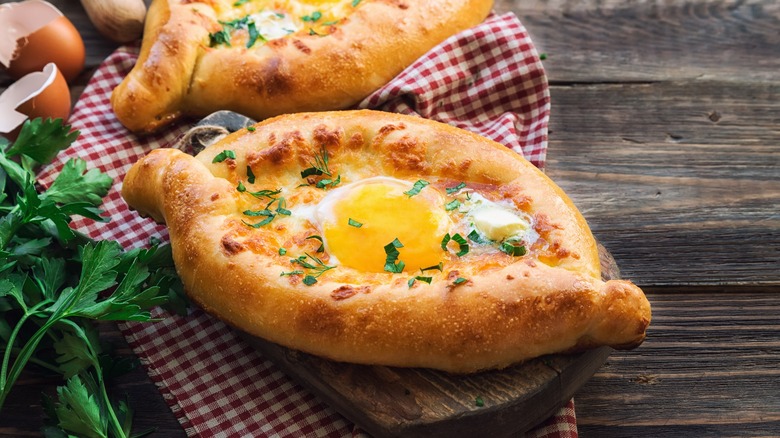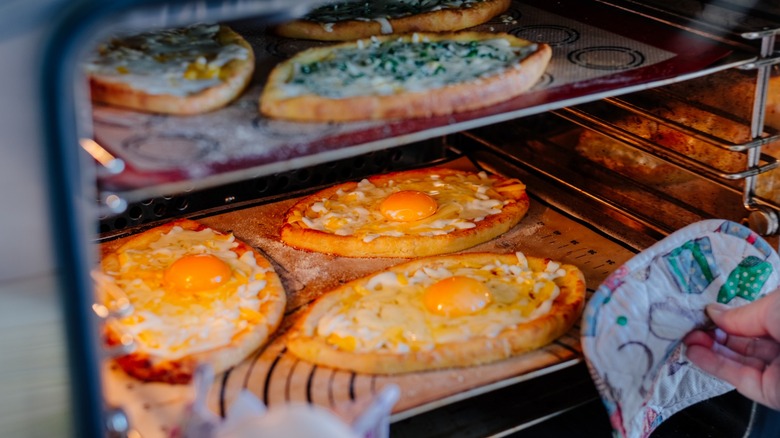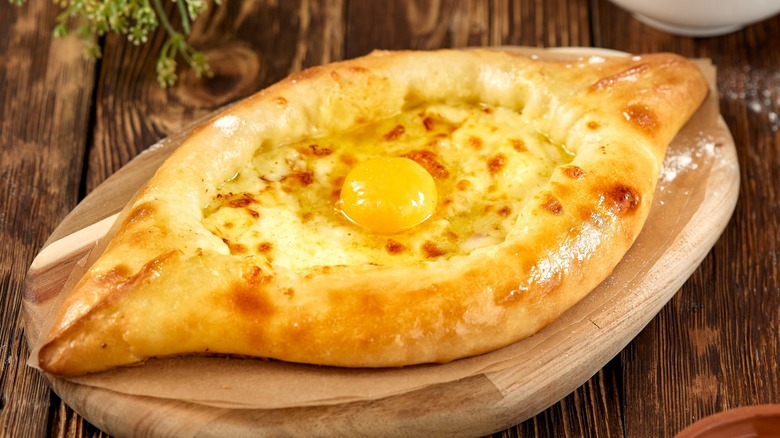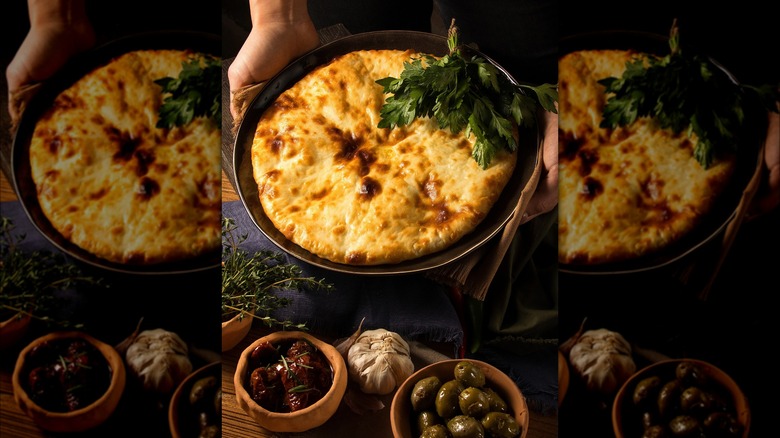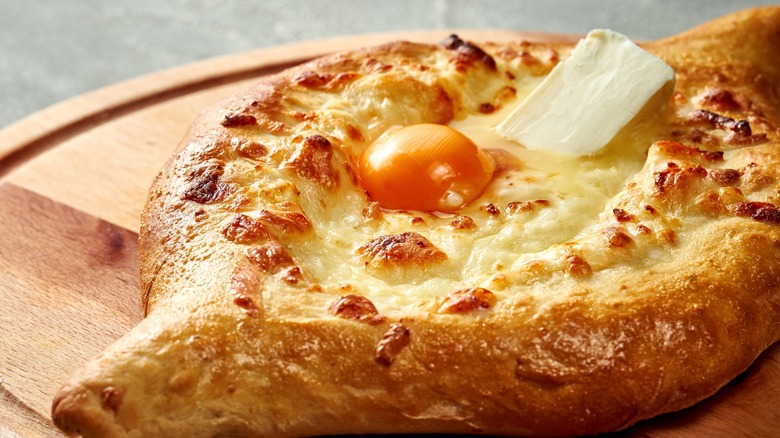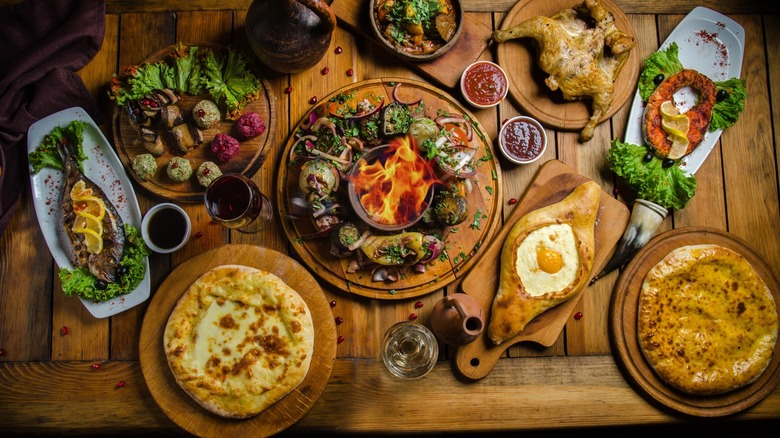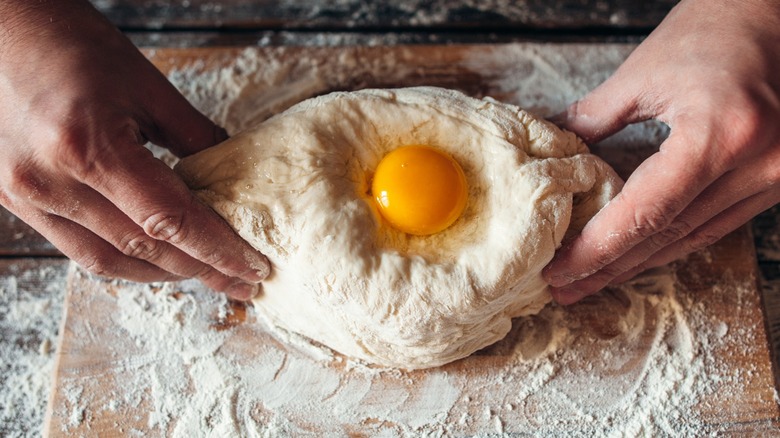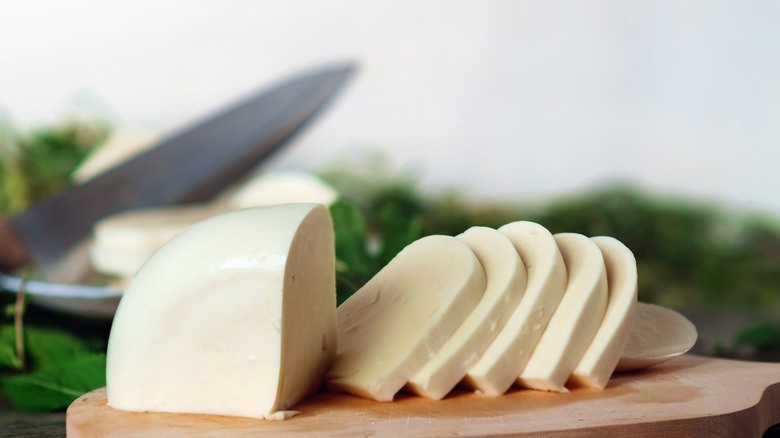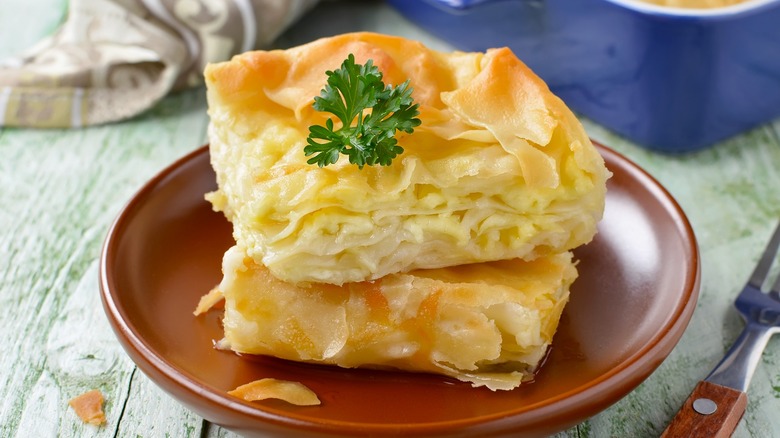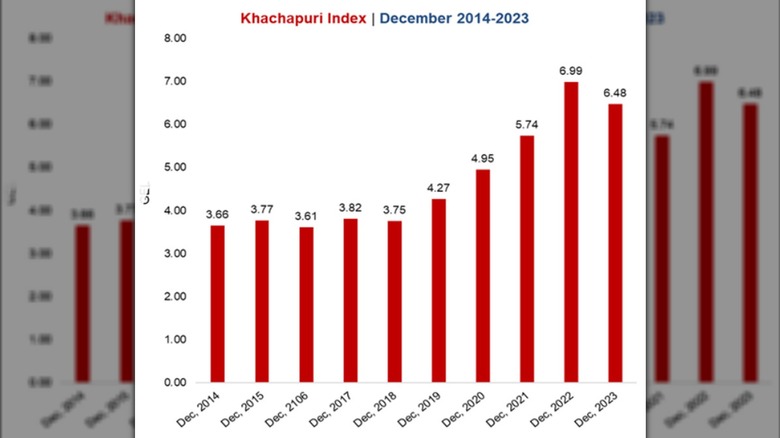Georgia's Ancient Cheese Bread: The Ultimate Guide To Khachapuri
Khachapuri, Georgia's ancient cheesy bread, is more than just a delicious accompaniment to the country's flavor-packed stews and sauces. For decades, it's been used by economists to measure the cost of living across Georgia's cities, something we'll explain more about later in this guide.
This cheesy delight also has a pretty rich history dating back thousands of years. In this ultimate guide, we'll look at the ancient origins of khachapuri, how it's made, what it tastes like, and how to serve it. We'll also dive into some of the many variations of khachapuri served in different regions of Georgia, and explain what makes each type so unique.
If you ever wanted to know everything about khachapuri, you've come to the right place. Appetites at the ready: If you're not hungry and craving some hot cheesy bread fresh from the oven by the end of this article, we're doing something wrong!
What is khachapuri?
If you're wondering how on earth to say "khachapuri," it's pronounced "hatch-ah-poo-re." The name actually comes from the Georgian words for cheese curds ("khacho") and bread ("puri"). At its heart, khachapuri is a chunky Georgian flatbread, shaped and topped or filled with cheese, though there are many regional variations that use different ingredients.
Some people swear that khachapuri should be shaped like a boat. Others make a round or square-shaped flatbread. Some versions are topped with an egg. Others incorporate potatoes, greens, meat, green onions, or butter. Even the types of cheese used vary. Some khachapuri uses sulguni, a salty, sour Georgian cheese. Some use aged cheeses, while others use mozzarella or similar cheeses that melt into long, stringy, oozy strands.
Khachapuri has been an intrinsic part of Georgian life for thousands of years. In fact, it has a pretty rich history that we'll dive into below.
Khachapuri's ancient origins
Khachapuri's history is a bit of a mystery. The earliest known recordings of the dish are from the 5th century BC, when Greek writers spoke of encountering it in the Colchis territory. However, the recordings do not refer to the dish as "khachapuri", and it's possible that, considering the many centuries that have since passed, this original khachapuri bears little resemblance to the cheesy bread we know and love today.
It may be that khachapuri dates back to Georgia's Renaissance in the 12th century. It could be pizza's early cousin from when Roman soldiers traversed the Black Sea area, bringing the recipe with them. This early form of pizza didn't include tomatoes, as they didn't exist yet in Europe, and wouldn't arrive until the 16th century. The word "khachapuri" wasn't mentioned in writing until 1725.
Georgian cuisine is a heady mix of European and Asian influences, due largely in part to the country being under occupation by different nations throughout history, including Mongol, Roman, Ottoman, Russian, and Persian forces. So it's little wonder that khachapuri feels influenced by both these cuisines — part pizza or flatbread and part naan bread.
Khachapuri has always been popular, even when Georgia was under its 70-year Soviet rule. At that time, only ten dishes were allowed to be served in state-run Georgian restaurants and traditional Imeruli Khachapuri was one of them.
How is Khachapuri made?
Khachapuri is generally a simple recipe, but it varies depending on the region. The bread can be cooked in a pan on the stove or in the oven. By far the most common variety is Imeruli Khachapuri, from Imereti. This is cooked on the stove and incorporates Imeruli cheese stuffing inside a simple dough.
Khachapuri can be made with or without yeast, depending on the recipe and the baker's preferences. Where yeast is not used, matsoni, a fermented dairy product, is commonly added. This isn't widely available outside Georgia, but its flavor is similar to buttermilk or kefir. Imeruli Khachapuri is rolled out into a circle, filled with cheese, and then gathered together at the top like a dumpling.
The story goes that there are as many versions of and recipes for khachapuri as there are kitchens in Georgia. To date, almost 50 distinct varieties have been noted. These vary in shape, method of cooking, fillings, and toppings, and we'll dive into them in more detail shortly.
What does Khachapuri taste like?
Imagine a pizza, but richer, and without tomatoes. Khachapuri dough isn't unlike pizza, but it's a bit richer, and, if yeast is used, fluffier. Where matsoni is added to the dough, there's a tangy flavor, not unlike sourdough.
The flavor profile of khachapuri really depends on the region the bread is from (or the recipe you're using) and the ingredients added. But make no bones about it, this is comfort food at its best: Rich, buttery, cheesy, doughy, and flaky. The method of cooking khachapuri also impacts its flavor. Khachapuri cooked on the stovetop will have a crispier base, while the oven-baked version is softer and often has cheese melted on top.
It's salty too, though just how salty it tastes depends largely on the cheese used. If you're using traditional Georgian sulguni, a buffalo milk cheese, take a moment to appreciate its unique sour, salty flavor. Smoked sulguni adds complexity to khachapuri. Aged cheese such as cow's milk Svanuri Narchvi has a crumbly texture and adds an extra layer of flavor to what is, at its heart, a simple cheese flatbread.
How to serve khachapuri
In Georgia, khachapuri is typically served alongside various other dishes for dinner. This versatile bread is also enjoyed for breakfast in some regions, or eaten as a snack at any time of day. Popular dishes to serve alongside khachapuri include chakhokhbili, a herby chicken stew, khinkali, soup-filled dumplings, and ajapsandali, a spicy, garlick-y Georgian vegetable stew.
In the past, women would prepare khachapuri for sailors returning from sea. The bread was eaten by hand, with the men breaking pieces off and dipping it in soft or melted cheese. To this day, it's common to eat khachapuri with your hands. Cutting the bread just means you end up with messy melted cheese, butter, and egg everywhere.
One of the joys of khachapuri is its versatility. If you're baking it at home, you can serve it with anything you like, from hearty soups and stews to a fresh walnut and feta salad. Or just enjoy it by itself. Preparing it with smoked cheese makes it the perfect accompaniment to an ice-cold beer.
Making or buying khachapuri
The decision whether to make or buy khachapuri may come down to where in the world you live. Though it's a staple of Georgian cuisine, khachapuri might be difficult to find if you reside outside a city. In the US, major cities may have specialist Georgian bakeries or grocery stores selling khachapuri.
With such a simple recipe, though, you might be best making your own khachapuri at home so you can enjoy it hot and fresh from the pan or oven. The main difficulty you may face when preparing khachapuri at home is sourcing Georgian cheese for the recipe. If you have a European or Spanish deli or grocery store in your city, you may find sulguni labeled as "Spanish fresh cheese" or "Portuguese fresh cheese."
Can't find sulguni in your neighborhood? Amazon sells traditional smoked sulguni, so you can have it shipped to your door. You can also sub a mix of mozzarella, feta, and ricotta, if all else fails. All you really need to make khachapuri at home is pizza dough, eggs, butter, and a variety of cheeses.
How to store khachapuri
Khachapuri is filled and/or topped with melted cheese, so as you can imagine, it tastes best eaten hot and fresh. That means if you're buying it from a bakery or store, you'll want to indulge right away. If you have any leftovers, you could store them wrapped in foil or in an airtight container in the fridge and enjoy them the next day. You can eat the leftover bread cold, but we'd recommend reheating it in a skillet to crisp it up and melt the cheese.
If you're making your own khachapuri, the same general rules apply. To enjoy it at its most delicious, serve it hot from the pan or oven. Leftovers will keep in the fridge, wrapped or in an airtight container for up to five days.
Though some recipes online state you can store khachapuri at room temperature, this depends on how warm the climate is where you live. To be safe, it's probably best to avoid keeping store-bought or homemade khachapuri on the counter, as they contain dairy products such as eggs and cheese, which could spoil.
How healthy a choice is khachapuri?
Khachapuri contains simple ingredients, and if you're making your own, there are no additives or hidden ingredients. It's a flatbread filled with or topped with a variety of cheeses, and often a pat of butter and an egg on top. Some khachapuri recipes contain other ingredients, but let's focus on the traditional Imeruli Khachapuri.
While the basic ingredients used for khachapuri aren't unhealthy per se, eating too much of this cheesy flatbread or indulging in it every day probably isn't the best idea, for a number of reasons. Butter is high in saturated fat, and while cheese is packed with calcium and protein, it's also high in saturated fat and sodium. Eating too much saturated fat can lead to an increase in LDL cholesterol. However, according to an international study published by BMJ Open Diabetes Research & Care, eating at least two servings of full-fat dairy daily may actually lower your risk of type 2 diabetes and high blood pressure, as well as other risks associated with developing cardiovascular disease.
Ultimately, khachapuri can be a healthy choice, provided you consume it in moderation. Of course, it also depends on what you serve it with. Try dishing up hearty, herby chicken chakhokhbili alongside your cheesy bread, or a fresh green lentil and arugula salad.
Regional variations of khachapuri
Though there are 50 known varieties of khachapuri, one thing is common across all variations: It must have cheese to be khachapuri. Regional cheeses are often used, including sulguni, Imeretian cheese, and Svanuri Narchvi, an aged cheese. Some recipes add caramelized onions, scallions, hard-boiled eggs, potatoes, meat, or wild greens.
In northern Georgia, khachapuri is flaky and shaped into a square, with a walnut in each corner to encourage a healthy walnut harvest. Achma, popular in western Georgia and Tbilisi, contains many cheese-filled layers, a bit like lasagne. In eastern Georgia, they make Mkhlovana, khachapuri filled with beetroot leaves and cheese.
Ajarian Khachapuri from Batumi is boat-shaped, filled with cheese and a soft-boiled egg in the middle to represent the sun setting over the sea. Butter is added on top to symbolize a good harvest and prosperity. Penovani Khachapuri, a popular street food, is more of a puff-pastry pie filled with cheese.
Measuring cost of living: The Khachapuri Index
With a rich history and a multitude of regional varieties, there's no doubt that khachapuri holds a central position in Georgian culture. But khachapuri isn't just a delicious cheesy treat — now, it's also an economic symbol. The popularity of this beloved Georgian bread, which is a staple in households throughout the nation, has prompted researchers to use the dish as a metric for cost of living.
Economists from the State University of Tbilisi use khachapuri to discover more about the cost of living in Georgian cities and inflation across the country, using the Khachapuri Index. The average household income is divided by the "Kh-index" — this is the energy (gas or electricity) used to produce one Imeretian Khachapuri, as well as how much the ingredients cost.
The resulting figure shows how many servings of Imeretian Khachapuri the average household can afford to make in each city across Georgia. With food prices rising globally, key ingredients for khachapuri have also been affected. In December 2022, the price of flour rose by 1%, cheese was up by 0.2%, and milk rose by 1.3%, leading to an all-time high for the Khachapuri Index at the end of 2022. Overall, the cost of preparing one khachapuri has risen by almost 100% between December 2014 and December 2023.
